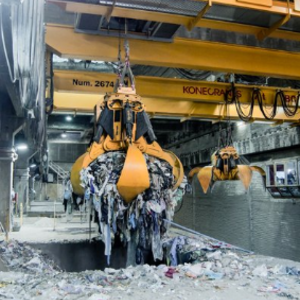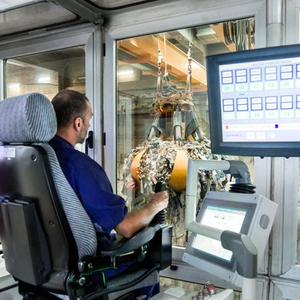Konecranes are introducing a broad range of lifting and material handling technologies specifically designed for waste-to-energy (WtE) and biomass applications for the Middle East.
The gulf region produces around 150 million tons of waste annually with vast quantities bound for municipal dumps and landfills. With the growing population, urbanization and economic expansion, consumption rates are growing while at the same time, the generation of solid waste amplifies. In order to address this issue, the region is looking to invest in waste to energy facilities, which will enable the disposal of waste more sustainably while creating energy.
Waste-to-Energy is the process of creating energy, usually in the form of electricity and steam, from the incineration of urban waste. Cranes play a crucial role in modern incineration plants, from the arrival of waste to separation to incineration. If cranes stop, the process is crippled and production halts. It is therefore key to specify lifting needs, (for instance the total burning capacity of a facility’s incinerators, the layout of handling areas and the type of waste being processed) to achieve optimum safety and reliability levels of the lifting equipment.
As an industry leader in overhead cranes and crane maintenance, Konecranes has a vast experience in serving the WtE industry. Konecranes offers a broad range of cranes and technologies, specifically designed for biomass, slag, sludge and waste handling applications. Till date, the company has delivered 668 cranes to 428 renewable energy plants worldwide, of which a large proportion are capable of operating in full automation.
Konecranes’ new standard solution for programming waste-to-energy automation is a Main User Interface (MUI). This computer is integrated with the crane’s PLC system and allows the operator to schedule and program 20 different work routines in full automation, giving plant managers enhanced flexibility to manage pit operations for receiving, mixing and burning waste.
An array of Smart Features help streamline load lifting and moving operations, increasing equipment ease of use and reducing material cycling time. For instance, integrated sway control systems allow for fast and precise movement of the grab and help to avoid collisions between the bucket and the pit walls. Furthermore, a proven automation system, helps to reduce operator fatigue, improves safety and allows the crane to operate to its full potential. “Konecranes has a variety of automation modes available to suit operational needs. These range from semi-automation (which is an operator initiated but PLC controlled feeding of the hopper in automation) to full-unmanned automation which includes all feeding, mixing and receiving operations. Essentially, completely autonomous crane pit operations can be managed via our Main User Interface. Automation helps improve facility safety, load travel accuracy and performance efficiency.” says Joseph Botros, Konecranes Director, Head of Waste to Energy Industry.
Most of WtE facilities operate in a nearly continuous cycle, where downtime and low performance levels having major detrimental effects on operations. Having the right crane, supported by a capable maintenance provider such as Konecranes, can mean the difference between managing operations more efficiently and safely.
Further information:
Tanja Wilson, META Marketing & Communication
[email protected]
Phone +971 4 815 6822 | Mobile +971 56 4141878

